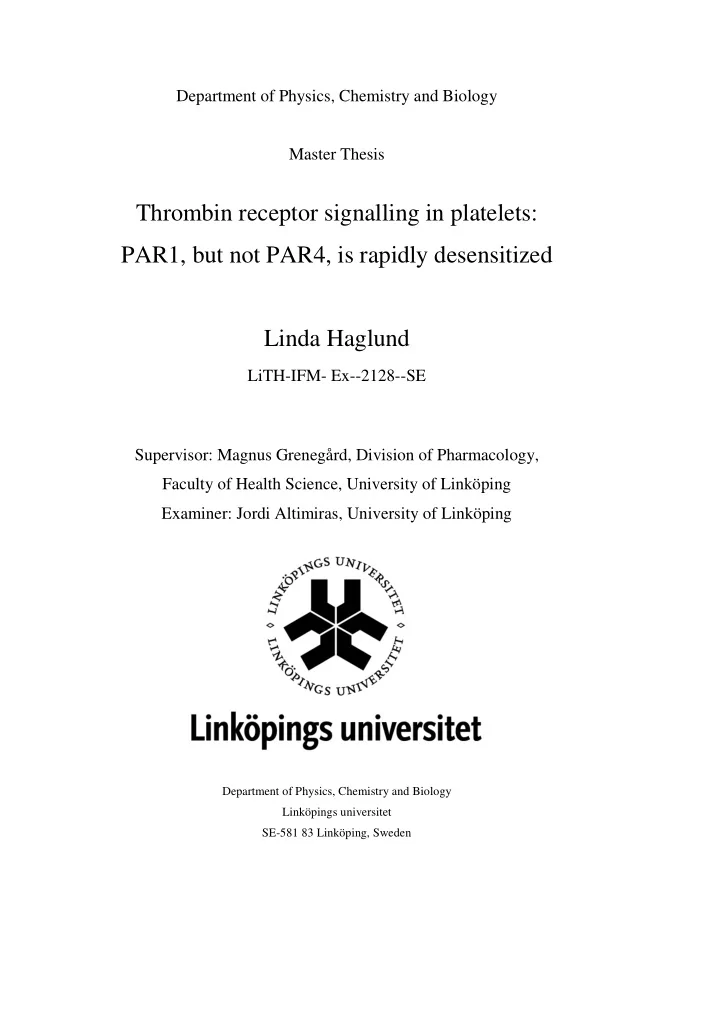

Department of Physics, Chemistry and Biology Master Thesis Thrombin receptor signalling in platelets: PAR1, but not PAR4, is rapidly desensitized Linda Haglund LiTH-IFM- Ex--2128--SE Supervisor: Magnus Grenegård, Division of Pharmacology, Faculty of Health Science, University of Linköping Examiner: Jordi Altimiras, University of Linköping Department of Physics, Chemistry and Biology Linköpings universitet SE-581 83 Linköping, Sweden
Avdelning, Institution Datum Division, Department Date Avdelningen för biologi 2009-05-18 Instutitionen för fysik och mätteknik Språk Rapporttyp ISBN Language Report category LITH-IFM- A-EX-- —09/2128—SE __________________________________________________ Svenska/Swedish Licentiatavhandling ISRN x Engelska/English x Examensarbete __________________________________________________ C-uppsats x D-uppsats ________________ Övrig rapport Serietitel och serienummer ISSN Title of series, numbering _______________ Handledare Supervisor: MagnusGrenegård URL för elektronisk version Ort Location: Linköping Titel Title: Thrombin receptor signaling in platelets: PAR1, but not PAR4, is rapidly desensitized Författare Author: Linda Haglund Sammanfattning Abstract: Platelets play a key role in primary haemostasis but are also related to the pathogenesis of arterial thrombosis. Thrombin is the most effective agonist inducing platelet activation. Human platelets express two G-protein coupled thrombin receptors (GPCRs), called protease activated receptor (PAR)1 and PAR4. The aim of this study was to clarify differences in the activities of PAR1 and PAR4, especially focusing on their resistance towards the platelet inhibitor nitric oxide (NO) and their ability to undergo desensitization. For this, PAR1- and PAR4- activating peptides (APs) (SFLLRN and AYPGKF, respectively) were used. Different aspects of platelet activities were studied: aggregation and the rise in intracellular Ca 2+ concentrations ([Ca 2+ ] i ). Aggregation was analyzed with lumiaggregometry, and [Ca 2+ ] i were studied using the fura-2 method. PKC substrate phosphorylation and the expression of PAR1 surface receptors were also analyzed, using Western blot and flow cytometry, respectively. The results from this study showed that NO exerted similar inhibitory effects on the two thrombin receptors. However, PAR1 and PAR4 differed in their ability to undergo desensitization. In cumulative dose-response studies, a low concentration of PAR1-AP induced desensitization of platelets towards higher PAR1-AP concentrations. This was not the case when studying PAR4-AP. The mechanism behind the desensitization of PAR1 to some part involved PKC, at least when studying the mobilization of intracellular Ca 2+ . PAR1 desensitization did not seem to involve receptor internalization and neither did it affect the activity of PAR4. This thus suggests that PAR4 might be a more suitable therapeutic target in the future management of thrombosis. Nyckelord Keyword: Nitric oxide, PAR1, PAR4, platelets, receptor desensitization
Content 1 Abstract ................................................................................................................................... 1 2 List of abbreviations................................................................................................................ 1 3 Introduction ............................................................................................................................. 1 4 Materials and methods ............................................................................................................ 3 4.1 Isolation of human platelets ............................................................................................. 3 4.2 Experimental setup........................................................................................................... 4 4.2.1 Resistance towards NO ............................................................................................. 4 4.2.2 The ability of PAR1 and PAR4 to undergo desensitization...................................... 4 4.2.3 PKC substrate phosphorylation................................................................................. 5 4.2.4 The expression of PAR1 surface receptors ............................................................... 5 4.3 Measurements................................................................................................................... 5 4.3.1 Measurements of platelet aggregation....................................................................... 5 4.3.2 Measurement of ATP secretion................................................................................. 5 4.3.3 Measurement of cytosolic Ca 2+ concentrations......................................................... 6 4.3.4 Western Blot.............................................................................................................. 6 4.3.5 Flow cytometry ......................................................................................................... 6 4.4 Drugs ................................................................................................................................ 7 4.5 Statistical analysis ............................................................................................................ 7 5 Results..................................................................................................................................... 7 5.1 The effect of NO on aggregation...................................................................................... 7 5.2 The effect of NO on intracellular Ca 2+ responses ............................................................ 9 5.3 The effect of NO and the importance of granule secretion............................................ 10 5.4 Cumulative dose-response studies ................................................................................. 10 5.5 The involvement of PKC in PAR1 desensitization........................................................ 13 5.6 PKC substrate phosphorylation...................................................................................... 16 5.7 PAR1 desensitization does not involve receptor internalization.................................... 19 6 Discussion ............................................................................................................................. 20 7 Acknowledgements ............................................................................................................... 22 8 References ............................................................................................................................. 22
Recommend
More recommend